Business Law Assignment: Contract Terms, Formation and Employment
VerifiedAdded on 2021/04/24
|13
|2828
|65
Homework Assignment
AI Summary
This business law assignment provides a detailed overview of key legal concepts, including the Unfair Contract Terms Act 1997, conditions, warranties, and frustrated contracts. It delves into case law, such as Parker v South Eastern Railway Co and the Sale of Goods Act 1979. The assignment further examines the process of transforming a bill into law and explores employment law, including the control test, the integrity test, and multiple tests for determining employee status, referencing cases like Yewens v Noake and Cassidy v Ministry of Health. Finally, it analyzes the formation of contracts, including the essential elements of offer and acceptance, with reference to cases like Harvey v Facey and Carlill v Carbolic Smoke Ball Co, and the postal rule of acceptance. The assignment provides a comprehensive understanding of these critical business law principles.
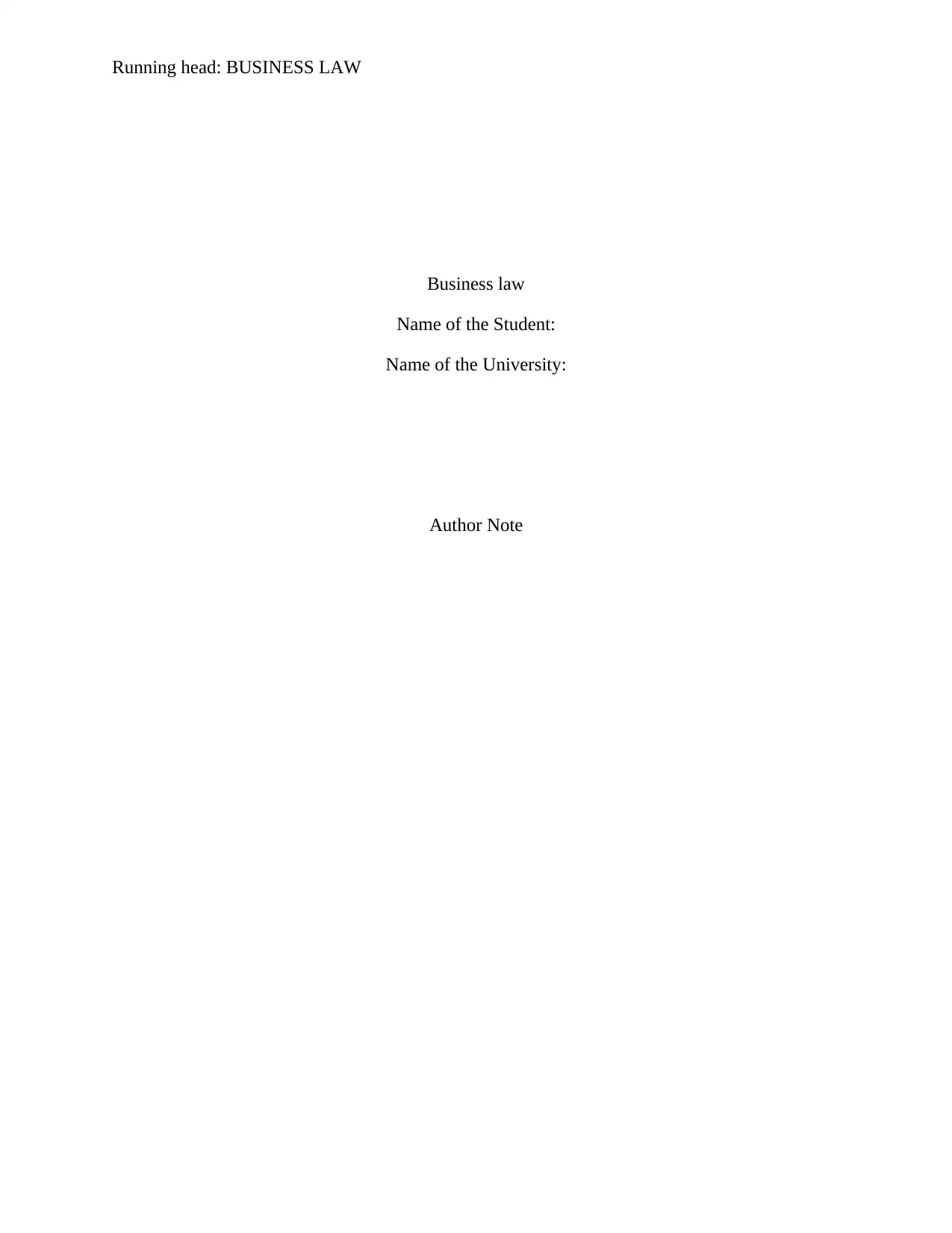
Running head: BUSINESS LAW
Business law
Name of the Student:
Name of the University:
Author Note
Business law
Name of the Student:
Name of the University:
Author Note
Paraphrase This Document
Need a fresh take? Get an instant paraphrase of this document with our AI Paraphraser
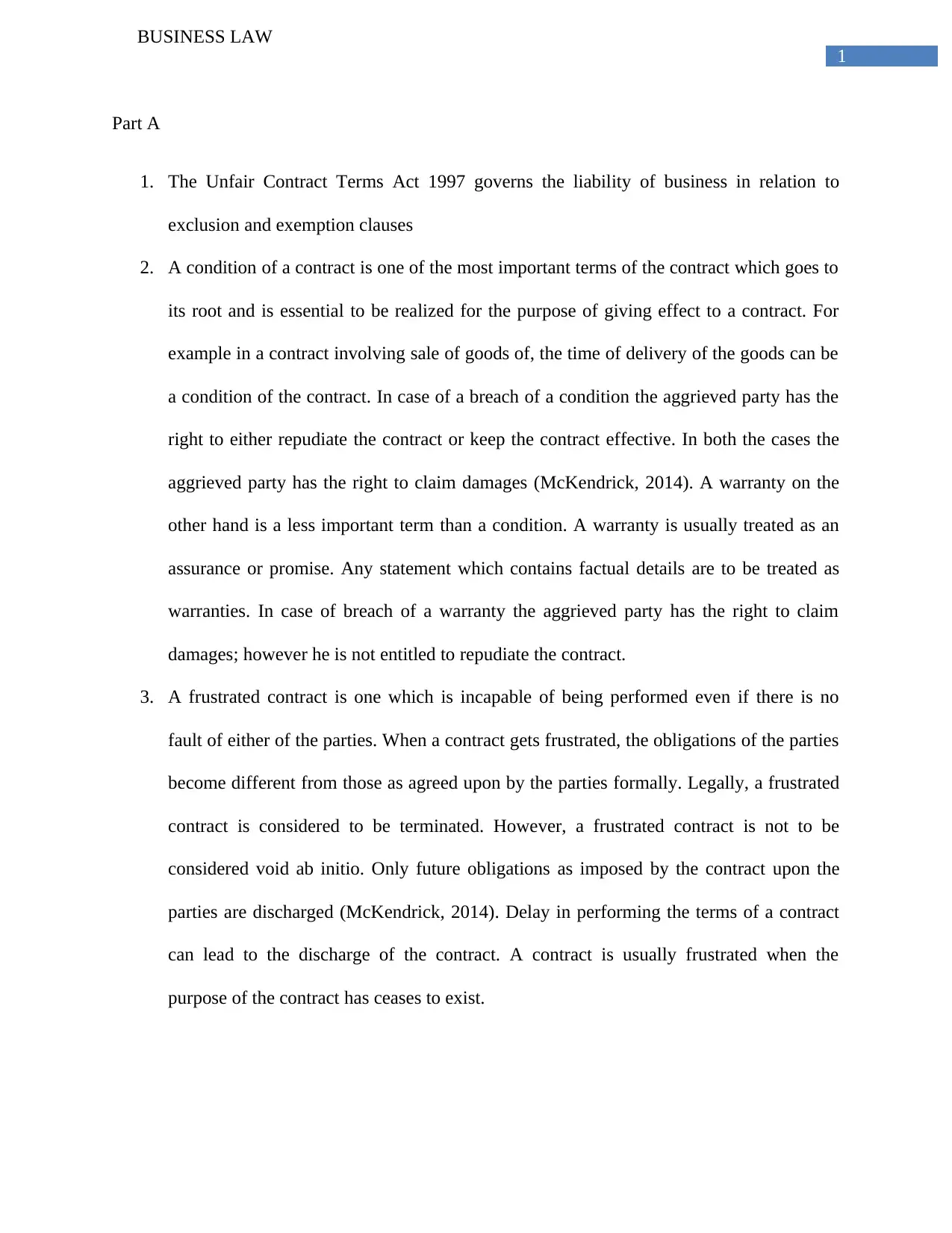
1
BUSINESS LAW
Part A
1. The Unfair Contract Terms Act 1997 governs the liability of business in relation to
exclusion and exemption clauses
2. A condition of a contract is one of the most important terms of the contract which goes to
its root and is essential to be realized for the purpose of giving effect to a contract. For
example in a contract involving sale of goods of, the time of delivery of the goods can be
a condition of the contract. In case of a breach of a condition the aggrieved party has the
right to either repudiate the contract or keep the contract effective. In both the cases the
aggrieved party has the right to claim damages (McKendrick, 2014). A warranty on the
other hand is a less important term than a condition. A warranty is usually treated as an
assurance or promise. Any statement which contains factual details are to be treated as
warranties. In case of breach of a warranty the aggrieved party has the right to claim
damages; however he is not entitled to repudiate the contract.
3. A frustrated contract is one which is incapable of being performed even if there is no
fault of either of the parties. When a contract gets frustrated, the obligations of the parties
become different from those as agreed upon by the parties formally. Legally, a frustrated
contract is considered to be terminated. However, a frustrated contract is not to be
considered void ab initio. Only future obligations as imposed by the contract upon the
parties are discharged (McKendrick, 2014). Delay in performing the terms of a contract
can lead to the discharge of the contract. A contract is usually frustrated when the
purpose of the contract has ceases to exist.
BUSINESS LAW
Part A
1. The Unfair Contract Terms Act 1997 governs the liability of business in relation to
exclusion and exemption clauses
2. A condition of a contract is one of the most important terms of the contract which goes to
its root and is essential to be realized for the purpose of giving effect to a contract. For
example in a contract involving sale of goods of, the time of delivery of the goods can be
a condition of the contract. In case of a breach of a condition the aggrieved party has the
right to either repudiate the contract or keep the contract effective. In both the cases the
aggrieved party has the right to claim damages (McKendrick, 2014). A warranty on the
other hand is a less important term than a condition. A warranty is usually treated as an
assurance or promise. Any statement which contains factual details are to be treated as
warranties. In case of breach of a warranty the aggrieved party has the right to claim
damages; however he is not entitled to repudiate the contract.
3. A frustrated contract is one which is incapable of being performed even if there is no
fault of either of the parties. When a contract gets frustrated, the obligations of the parties
become different from those as agreed upon by the parties formally. Legally, a frustrated
contract is considered to be terminated. However, a frustrated contract is not to be
considered void ab initio. Only future obligations as imposed by the contract upon the
parties are discharged (McKendrick, 2014). Delay in performing the terms of a contract
can lead to the discharge of the contract. A contract is usually frustrated when the
purpose of the contract has ceases to exist.
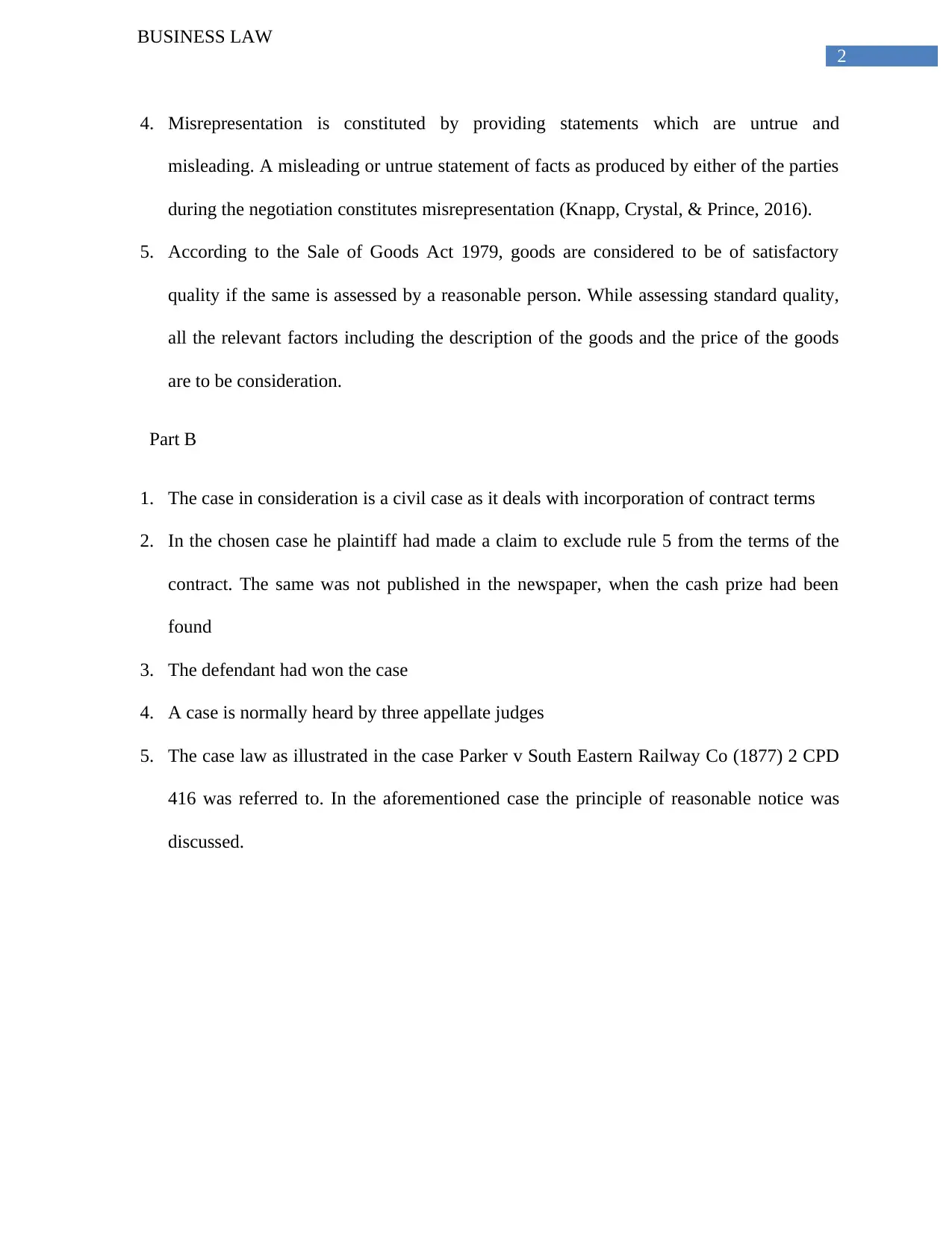
2
BUSINESS LAW
4. Misrepresentation is constituted by providing statements which are untrue and
misleading. A misleading or untrue statement of facts as produced by either of the parties
during the negotiation constitutes misrepresentation (Knapp, Crystal, & Prince, 2016).
5. According to the Sale of Goods Act 1979, goods are considered to be of satisfactory
quality if the same is assessed by a reasonable person. While assessing standard quality,
all the relevant factors including the description of the goods and the price of the goods
are to be consideration.
Part B
1. The case in consideration is a civil case as it deals with incorporation of contract terms
2. In the chosen case he plaintiff had made a claim to exclude rule 5 from the terms of the
contract. The same was not published in the newspaper, when the cash prize had been
found
3. The defendant had won the case
4. A case is normally heard by three appellate judges
5. The case law as illustrated in the case Parker v South Eastern Railway Co (1877) 2 CPD
416 was referred to. In the aforementioned case the principle of reasonable notice was
discussed.
BUSINESS LAW
4. Misrepresentation is constituted by providing statements which are untrue and
misleading. A misleading or untrue statement of facts as produced by either of the parties
during the negotiation constitutes misrepresentation (Knapp, Crystal, & Prince, 2016).
5. According to the Sale of Goods Act 1979, goods are considered to be of satisfactory
quality if the same is assessed by a reasonable person. While assessing standard quality,
all the relevant factors including the description of the goods and the price of the goods
are to be consideration.
Part B
1. The case in consideration is a civil case as it deals with incorporation of contract terms
2. In the chosen case he plaintiff had made a claim to exclude rule 5 from the terms of the
contract. The same was not published in the newspaper, when the cash prize had been
found
3. The defendant had won the case
4. A case is normally heard by three appellate judges
5. The case law as illustrated in the case Parker v South Eastern Railway Co (1877) 2 CPD
416 was referred to. In the aforementioned case the principle of reasonable notice was
discussed.
⊘ This is a preview!⊘
Do you want full access?
Subscribe today to unlock all pages.

Trusted by 1+ million students worldwide
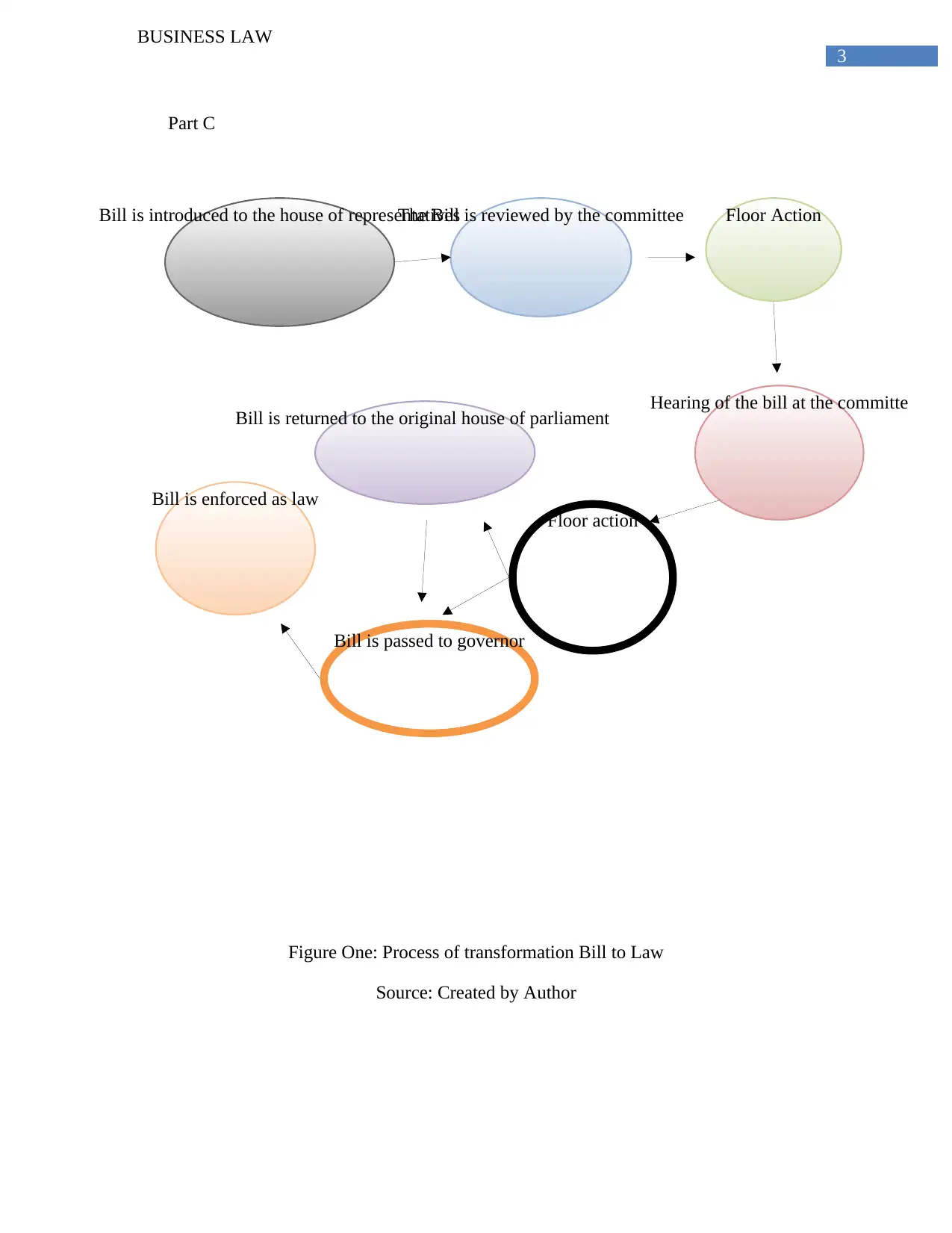
3
BUSINESS LAW
Bill is introduced to the house of representativesThe Bill is reviewed by the committee
Hearing of the bill at the committe
Floor Action
Floor action
Bill is enforced as law
Bill is returned to the original house of parliament
Bill is passed to governor
Part C
Figure One: Process of transformation Bill to Law
Source: Created by Author
BUSINESS LAW
Bill is introduced to the house of representativesThe Bill is reviewed by the committee
Hearing of the bill at the committe
Floor Action
Floor action
Bill is enforced as law
Bill is returned to the original house of parliament
Bill is passed to governor
Part C
Figure One: Process of transformation Bill to Law
Source: Created by Author
Paraphrase This Document
Need a fresh take? Get an instant paraphrase of this document with our AI Paraphraser
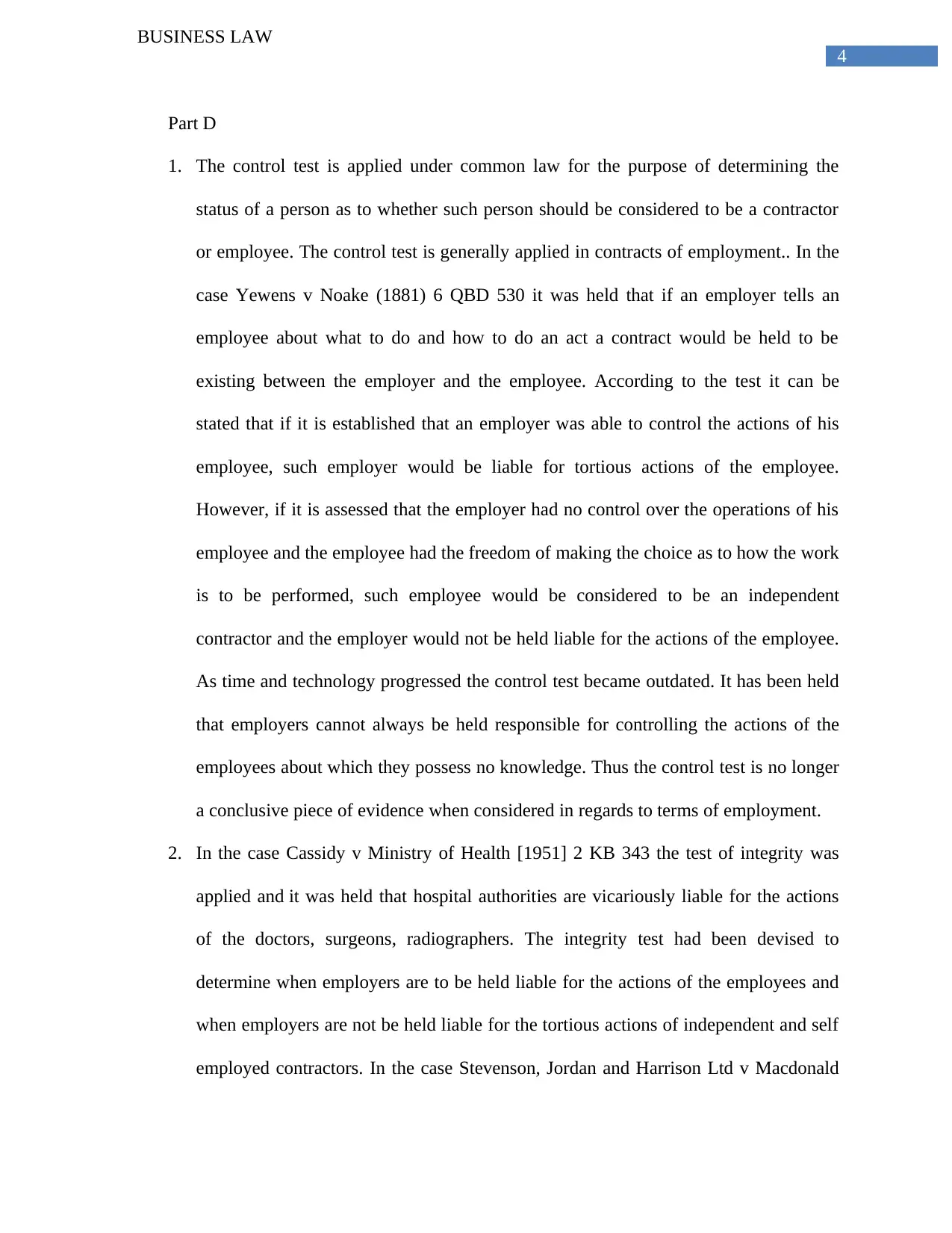
4
BUSINESS LAW
Part D
1. The control test is applied under common law for the purpose of determining the
status of a person as to whether such person should be considered to be a contractor
or employee. The control test is generally applied in contracts of employment.. In the
case Yewens v Noake (1881) 6 QBD 530 it was held that if an employer tells an
employee about what to do and how to do an act a contract would be held to be
existing between the employer and the employee. According to the test it can be
stated that if it is established that an employer was able to control the actions of his
employee, such employer would be liable for tortious actions of the employee.
However, if it is assessed that the employer had no control over the operations of his
employee and the employee had the freedom of making the choice as to how the work
is to be performed, such employee would be considered to be an independent
contractor and the employer would not be held liable for the actions of the employee.
As time and technology progressed the control test became outdated. It has been held
that employers cannot always be held responsible for controlling the actions of the
employees about which they possess no knowledge. Thus the control test is no longer
a conclusive piece of evidence when considered in regards to terms of employment.
2. In the case Cassidy v Ministry of Health [1951] 2 KB 343 the test of integrity was
applied and it was held that hospital authorities are vicariously liable for the actions
of the doctors, surgeons, radiographers. The integrity test had been devised to
determine when employers are to be held liable for the actions of the employees and
when employers are not be held liable for the tortious actions of independent and self
employed contractors. In the case Stevenson, Jordan and Harrison Ltd v Macdonald
BUSINESS LAW
Part D
1. The control test is applied under common law for the purpose of determining the
status of a person as to whether such person should be considered to be a contractor
or employee. The control test is generally applied in contracts of employment.. In the
case Yewens v Noake (1881) 6 QBD 530 it was held that if an employer tells an
employee about what to do and how to do an act a contract would be held to be
existing between the employer and the employee. According to the test it can be
stated that if it is established that an employer was able to control the actions of his
employee, such employer would be liable for tortious actions of the employee.
However, if it is assessed that the employer had no control over the operations of his
employee and the employee had the freedom of making the choice as to how the work
is to be performed, such employee would be considered to be an independent
contractor and the employer would not be held liable for the actions of the employee.
As time and technology progressed the control test became outdated. It has been held
that employers cannot always be held responsible for controlling the actions of the
employees about which they possess no knowledge. Thus the control test is no longer
a conclusive piece of evidence when considered in regards to terms of employment.
2. In the case Cassidy v Ministry of Health [1951] 2 KB 343 the test of integrity was
applied and it was held that hospital authorities are vicariously liable for the actions
of the doctors, surgeons, radiographers. The integrity test had been devised to
determine when employers are to be held liable for the actions of the employees and
when employers are not be held liable for the tortious actions of independent and self
employed contractors. In the case Stevenson, Jordan and Harrison Ltd v Macdonald
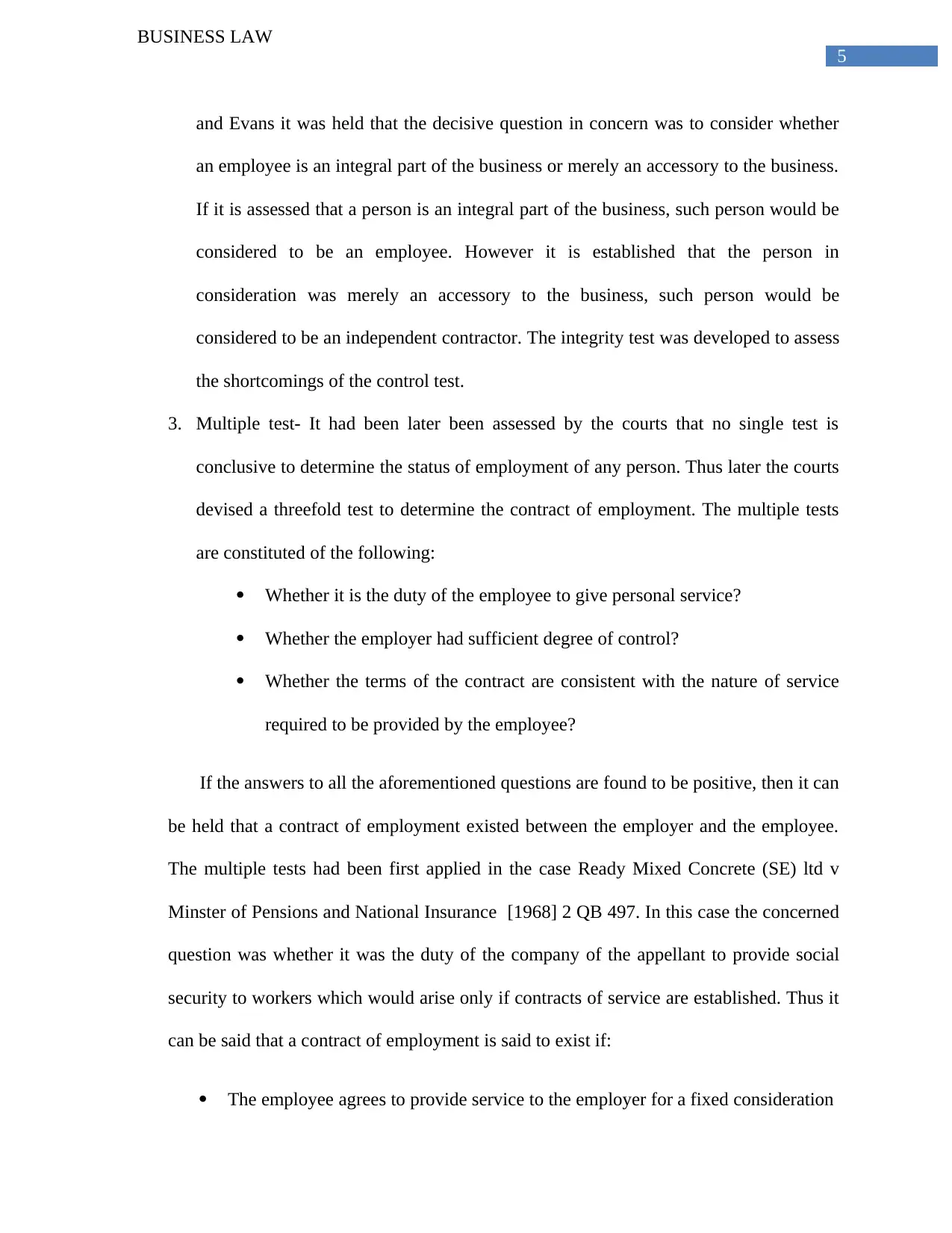
5
BUSINESS LAW
and Evans it was held that the decisive question in concern was to consider whether
an employee is an integral part of the business or merely an accessory to the business.
If it is assessed that a person is an integral part of the business, such person would be
considered to be an employee. However it is established that the person in
consideration was merely an accessory to the business, such person would be
considered to be an independent contractor. The integrity test was developed to assess
the shortcomings of the control test.
3. Multiple test- It had been later been assessed by the courts that no single test is
conclusive to determine the status of employment of any person. Thus later the courts
devised a threefold test to determine the contract of employment. The multiple tests
are constituted of the following:
Whether it is the duty of the employee to give personal service?
Whether the employer had sufficient degree of control?
Whether the terms of the contract are consistent with the nature of service
required to be provided by the employee?
If the answers to all the aforementioned questions are found to be positive, then it can
be held that a contract of employment existed between the employer and the employee.
The multiple tests had been first applied in the case Ready Mixed Concrete (SE) ltd v
Minster of Pensions and National Insurance [1968] 2 QB 497. In this case the concerned
question was whether it was the duty of the company of the appellant to provide social
security to workers which would arise only if contracts of service are established. Thus it
can be said that a contract of employment is said to exist if:
The employee agrees to provide service to the employer for a fixed consideration
BUSINESS LAW
and Evans it was held that the decisive question in concern was to consider whether
an employee is an integral part of the business or merely an accessory to the business.
If it is assessed that a person is an integral part of the business, such person would be
considered to be an employee. However it is established that the person in
consideration was merely an accessory to the business, such person would be
considered to be an independent contractor. The integrity test was developed to assess
the shortcomings of the control test.
3. Multiple test- It had been later been assessed by the courts that no single test is
conclusive to determine the status of employment of any person. Thus later the courts
devised a threefold test to determine the contract of employment. The multiple tests
are constituted of the following:
Whether it is the duty of the employee to give personal service?
Whether the employer had sufficient degree of control?
Whether the terms of the contract are consistent with the nature of service
required to be provided by the employee?
If the answers to all the aforementioned questions are found to be positive, then it can
be held that a contract of employment existed between the employer and the employee.
The multiple tests had been first applied in the case Ready Mixed Concrete (SE) ltd v
Minster of Pensions and National Insurance [1968] 2 QB 497. In this case the concerned
question was whether it was the duty of the company of the appellant to provide social
security to workers which would arise only if contracts of service are established. Thus it
can be said that a contract of employment is said to exist if:
The employee agrees to provide service to the employer for a fixed consideration
⊘ This is a preview!⊘
Do you want full access?
Subscribe today to unlock all pages.

Trusted by 1+ million students worldwide
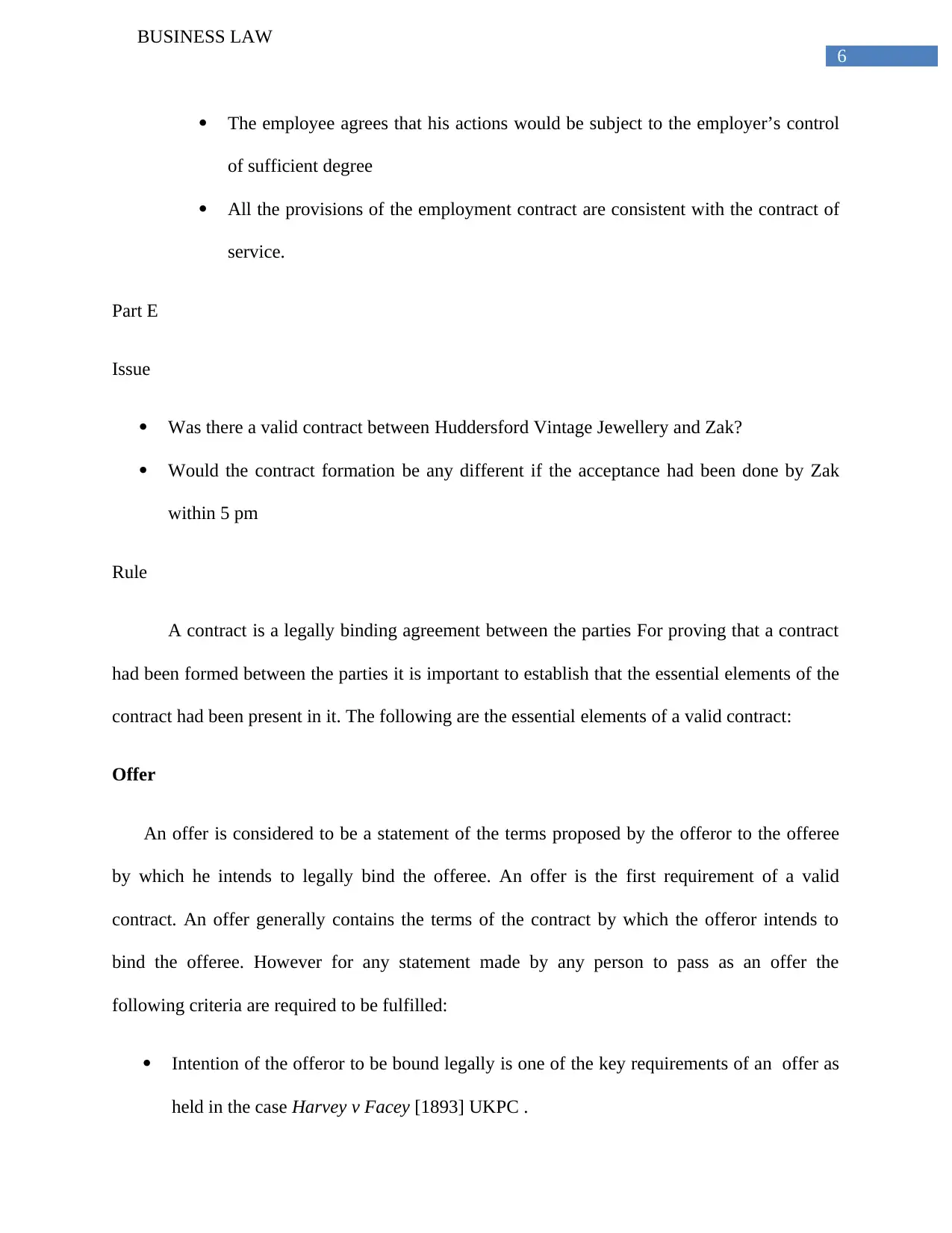
6
BUSINESS LAW
The employee agrees that his actions would be subject to the employer’s control
of sufficient degree
All the provisions of the employment contract are consistent with the contract of
service.
Part E
Issue
Was there a valid contract between Huddersford Vintage Jewellery and Zak?
Would the contract formation be any different if the acceptance had been done by Zak
within 5 pm
Rule
A contract is a legally binding agreement between the parties For proving that a contract
had been formed between the parties it is important to establish that the essential elements of the
contract had been present in it. The following are the essential elements of a valid contract:
Offer
An offer is considered to be a statement of the terms proposed by the offeror to the offeree
by which he intends to legally bind the offeree. An offer is the first requirement of a valid
contract. An offer generally contains the terms of the contract by which the offeror intends to
bind the offeree. However for any statement made by any person to pass as an offer the
following criteria are required to be fulfilled:
Intention of the offeror to be bound legally is one of the key requirements of an offer as
held in the case Harvey v Facey [1893] UKPC .
BUSINESS LAW
The employee agrees that his actions would be subject to the employer’s control
of sufficient degree
All the provisions of the employment contract are consistent with the contract of
service.
Part E
Issue
Was there a valid contract between Huddersford Vintage Jewellery and Zak?
Would the contract formation be any different if the acceptance had been done by Zak
within 5 pm
Rule
A contract is a legally binding agreement between the parties For proving that a contract
had been formed between the parties it is important to establish that the essential elements of the
contract had been present in it. The following are the essential elements of a valid contract:
Offer
An offer is considered to be a statement of the terms proposed by the offeror to the offeree
by which he intends to legally bind the offeree. An offer is the first requirement of a valid
contract. An offer generally contains the terms of the contract by which the offeror intends to
bind the offeree. However for any statement made by any person to pass as an offer the
following criteria are required to be fulfilled:
Intention of the offeror to be bound legally is one of the key requirements of an offer as
held in the case Harvey v Facey [1893] UKPC .
Paraphrase This Document
Need a fresh take? Get an instant paraphrase of this document with our AI Paraphraser
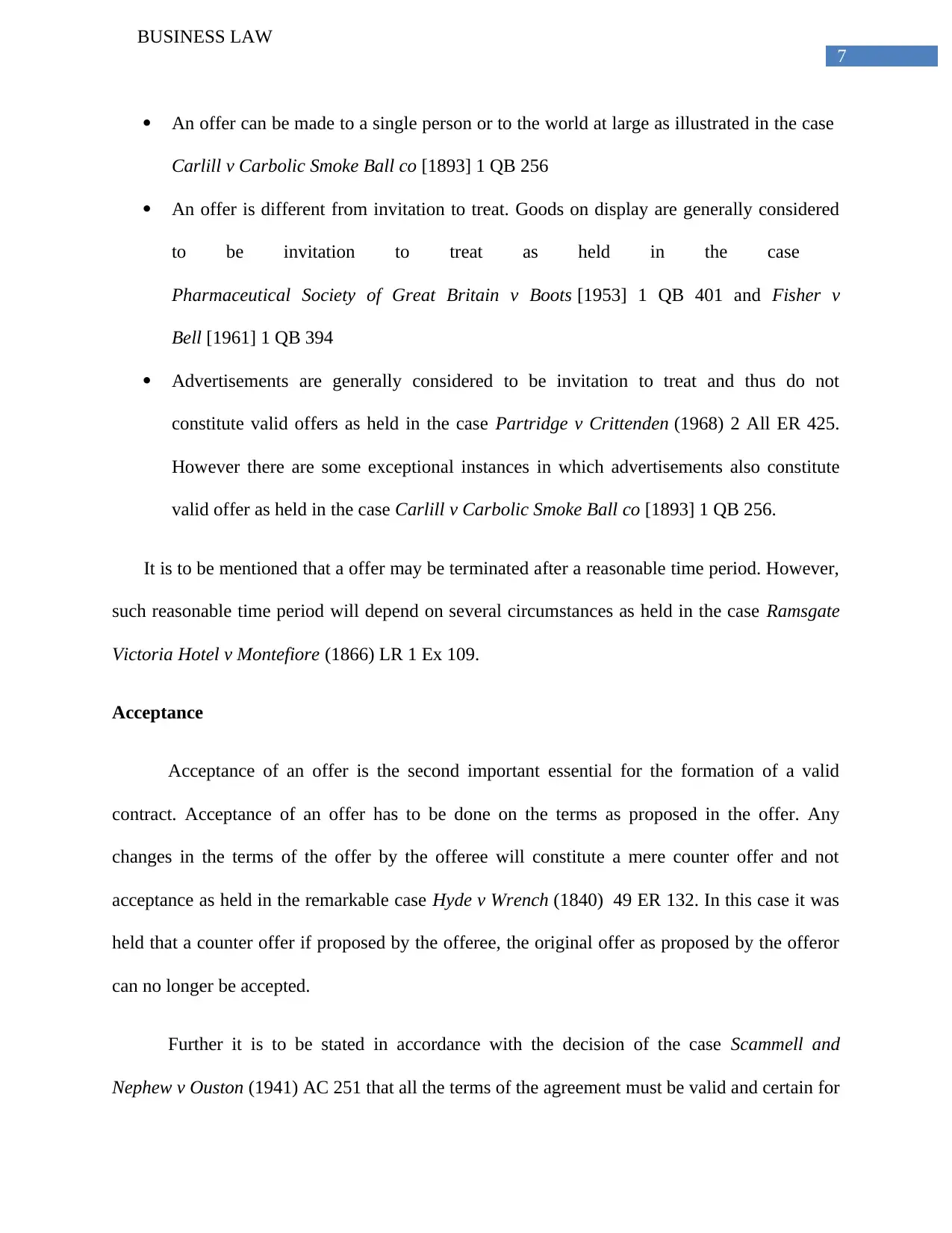
7
BUSINESS LAW
An offer can be made to a single person or to the world at large as illustrated in the case
Carlill v Carbolic Smoke Ball co [1893] 1 QB 256
An offer is different from invitation to treat. Goods on display are generally considered
to be invitation to treat as held in the case
Pharmaceutical Society of Great Britain v Boots [1953] 1 QB 401 and Fisher v
Bell [1961] 1 QB 394
Advertisements are generally considered to be invitation to treat and thus do not
constitute valid offers as held in the case Partridge v Crittenden (1968) 2 All ER 425.
However there are some exceptional instances in which advertisements also constitute
valid offer as held in the case Carlill v Carbolic Smoke Ball co [1893] 1 QB 256.
It is to be mentioned that a offer may be terminated after a reasonable time period. However,
such reasonable time period will depend on several circumstances as held in the case Ramsgate
Victoria Hotel v Montefiore (1866) LR 1 Ex 109.
Acceptance
Acceptance of an offer is the second important essential for the formation of a valid
contract. Acceptance of an offer has to be done on the terms as proposed in the offer. Any
changes in the terms of the offer by the offeree will constitute a mere counter offer and not
acceptance as held in the remarkable case Hyde v Wrench (1840) 49 ER 132. In this case it was
held that a counter offer if proposed by the offeree, the original offer as proposed by the offeror
can no longer be accepted.
Further it is to be stated in accordance with the decision of the case Scammell and
Nephew v Ouston (1941) AC 251 that all the terms of the agreement must be valid and certain for
BUSINESS LAW
An offer can be made to a single person or to the world at large as illustrated in the case
Carlill v Carbolic Smoke Ball co [1893] 1 QB 256
An offer is different from invitation to treat. Goods on display are generally considered
to be invitation to treat as held in the case
Pharmaceutical Society of Great Britain v Boots [1953] 1 QB 401 and Fisher v
Bell [1961] 1 QB 394
Advertisements are generally considered to be invitation to treat and thus do not
constitute valid offers as held in the case Partridge v Crittenden (1968) 2 All ER 425.
However there are some exceptional instances in which advertisements also constitute
valid offer as held in the case Carlill v Carbolic Smoke Ball co [1893] 1 QB 256.
It is to be mentioned that a offer may be terminated after a reasonable time period. However,
such reasonable time period will depend on several circumstances as held in the case Ramsgate
Victoria Hotel v Montefiore (1866) LR 1 Ex 109.
Acceptance
Acceptance of an offer is the second important essential for the formation of a valid
contract. Acceptance of an offer has to be done on the terms as proposed in the offer. Any
changes in the terms of the offer by the offeree will constitute a mere counter offer and not
acceptance as held in the remarkable case Hyde v Wrench (1840) 49 ER 132. In this case it was
held that a counter offer if proposed by the offeree, the original offer as proposed by the offeror
can no longer be accepted.
Further it is to be stated in accordance with the decision of the case Scammell and
Nephew v Ouston (1941) AC 251 that all the terms of the agreement must be valid and certain for
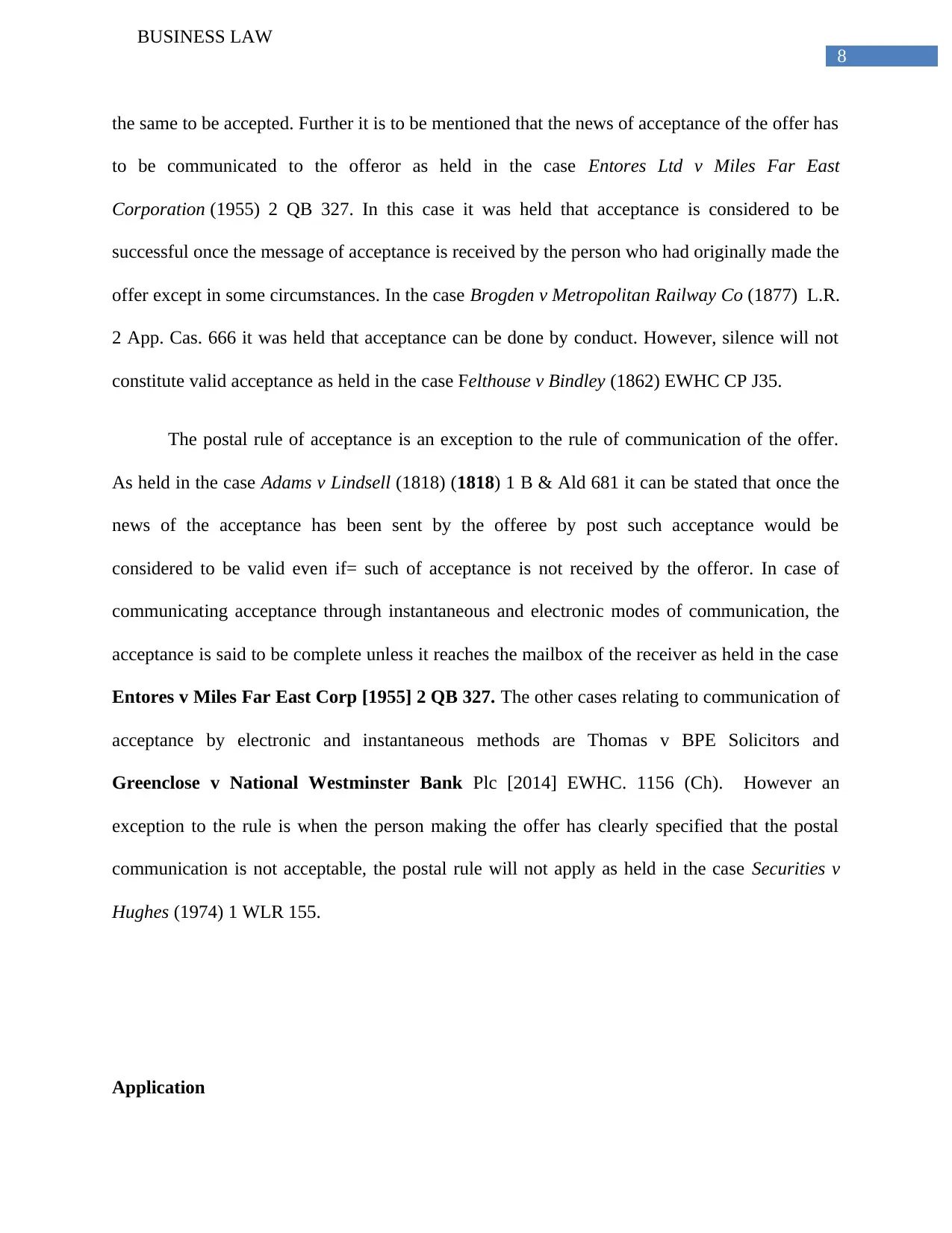
8
BUSINESS LAW
the same to be accepted. Further it is to be mentioned that the news of acceptance of the offer has
to be communicated to the offeror as held in the case Entores Ltd v Miles Far East
Corporation (1955) 2 QB 327. In this case it was held that acceptance is considered to be
successful once the message of acceptance is received by the person who had originally made the
offer except in some circumstances. In the case Brogden v Metropolitan Railway Co (1877) L.R.
2 App. Cas. 666 it was held that acceptance can be done by conduct. However, silence will not
constitute valid acceptance as held in the case Felthouse v Bindley (1862) EWHC CP J35.
The postal rule of acceptance is an exception to the rule of communication of the offer.
As held in the case Adams v Lindsell (1818) (1818) 1 B & Ald 681 it can be stated that once the
news of the acceptance has been sent by the offeree by post such acceptance would be
considered to be valid even if= such of acceptance is not received by the offeror. In case of
communicating acceptance through instantaneous and electronic modes of communication, the
acceptance is said to be complete unless it reaches the mailbox of the receiver as held in the case
Entores v Miles Far East Corp [1955] 2 QB 327. The other cases relating to communication of
acceptance by electronic and instantaneous methods are Thomas v BPE Solicitors and
Greenclose v National Westminster Bank Plc [2014] EWHC. 1156 (Ch). However an
exception to the rule is when the person making the offer has clearly specified that the postal
communication is not acceptable, the postal rule will not apply as held in the case Securities v
Hughes (1974) 1 WLR 155.
Application
BUSINESS LAW
the same to be accepted. Further it is to be mentioned that the news of acceptance of the offer has
to be communicated to the offeror as held in the case Entores Ltd v Miles Far East
Corporation (1955) 2 QB 327. In this case it was held that acceptance is considered to be
successful once the message of acceptance is received by the person who had originally made the
offer except in some circumstances. In the case Brogden v Metropolitan Railway Co (1877) L.R.
2 App. Cas. 666 it was held that acceptance can be done by conduct. However, silence will not
constitute valid acceptance as held in the case Felthouse v Bindley (1862) EWHC CP J35.
The postal rule of acceptance is an exception to the rule of communication of the offer.
As held in the case Adams v Lindsell (1818) (1818) 1 B & Ald 681 it can be stated that once the
news of the acceptance has been sent by the offeree by post such acceptance would be
considered to be valid even if= such of acceptance is not received by the offeror. In case of
communicating acceptance through instantaneous and electronic modes of communication, the
acceptance is said to be complete unless it reaches the mailbox of the receiver as held in the case
Entores v Miles Far East Corp [1955] 2 QB 327. The other cases relating to communication of
acceptance by electronic and instantaneous methods are Thomas v BPE Solicitors and
Greenclose v National Westminster Bank Plc [2014] EWHC. 1156 (Ch). However an
exception to the rule is when the person making the offer has clearly specified that the postal
communication is not acceptable, the postal rule will not apply as held in the case Securities v
Hughes (1974) 1 WLR 155.
Application
⊘ This is a preview!⊘
Do you want full access?
Subscribe today to unlock all pages.

Trusted by 1+ million students worldwide
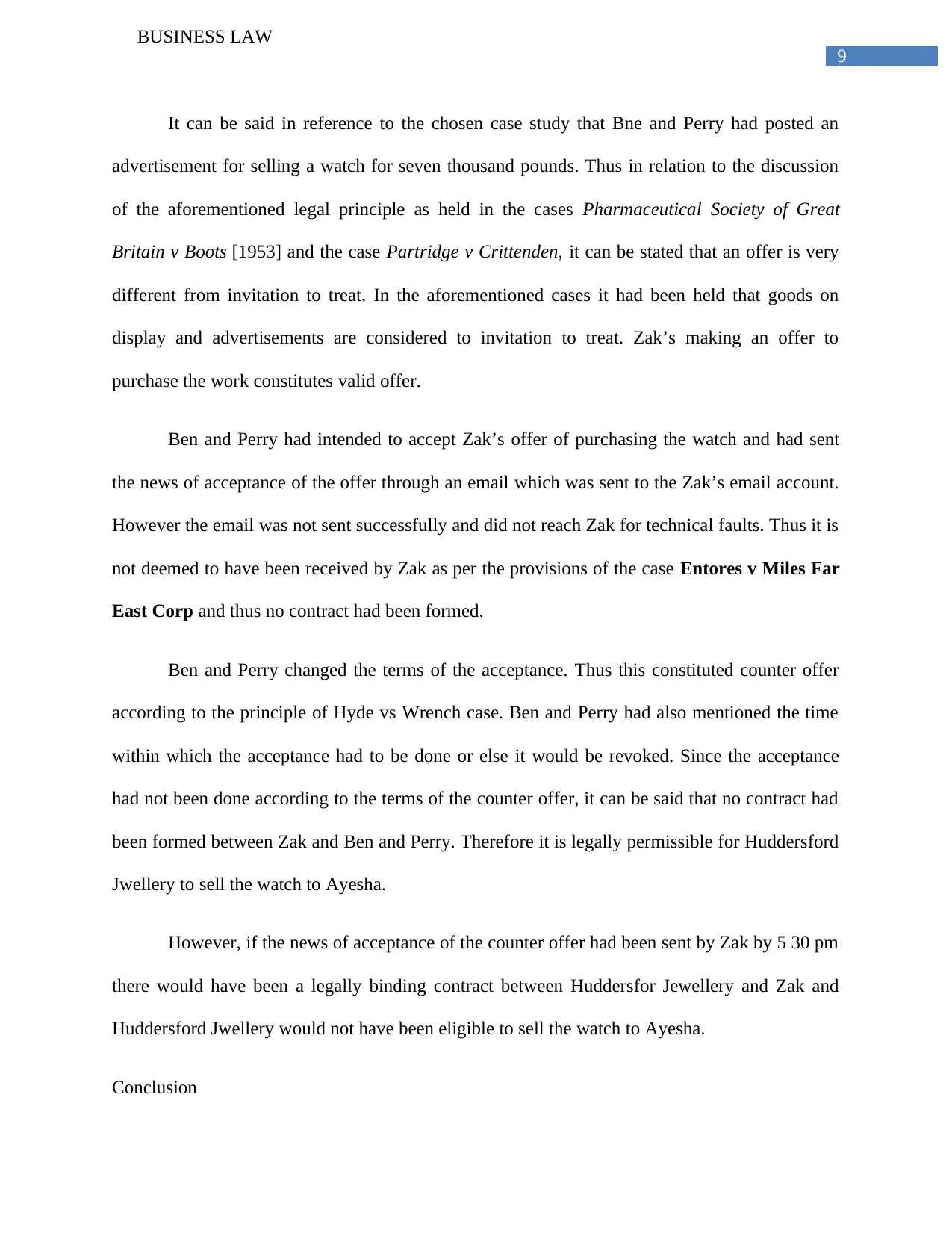
9
BUSINESS LAW
It can be said in reference to the chosen case study that Bne and Perry had posted an
advertisement for selling a watch for seven thousand pounds. Thus in relation to the discussion
of the aforementioned legal principle as held in the cases Pharmaceutical Society of Great
Britain v Boots [1953] and the case Partridge v Crittenden, it can be stated that an offer is very
different from invitation to treat. In the aforementioned cases it had been held that goods on
display and advertisements are considered to invitation to treat. Zak’s making an offer to
purchase the work constitutes valid offer.
Ben and Perry had intended to accept Zak’s offer of purchasing the watch and had sent
the news of acceptance of the offer through an email which was sent to the Zak’s email account.
However the email was not sent successfully and did not reach Zak for technical faults. Thus it is
not deemed to have been received by Zak as per the provisions of the case Entores v Miles Far
East Corp and thus no contract had been formed.
Ben and Perry changed the terms of the acceptance. Thus this constituted counter offer
according to the principle of Hyde vs Wrench case. Ben and Perry had also mentioned the time
within which the acceptance had to be done or else it would be revoked. Since the acceptance
had not been done according to the terms of the counter offer, it can be said that no contract had
been formed between Zak and Ben and Perry. Therefore it is legally permissible for Huddersford
Jwellery to sell the watch to Ayesha.
However, if the news of acceptance of the counter offer had been sent by Zak by 5 30 pm
there would have been a legally binding contract between Huddersfor Jewellery and Zak and
Huddersford Jwellery would not have been eligible to sell the watch to Ayesha.
Conclusion
BUSINESS LAW
It can be said in reference to the chosen case study that Bne and Perry had posted an
advertisement for selling a watch for seven thousand pounds. Thus in relation to the discussion
of the aforementioned legal principle as held in the cases Pharmaceutical Society of Great
Britain v Boots [1953] and the case Partridge v Crittenden, it can be stated that an offer is very
different from invitation to treat. In the aforementioned cases it had been held that goods on
display and advertisements are considered to invitation to treat. Zak’s making an offer to
purchase the work constitutes valid offer.
Ben and Perry had intended to accept Zak’s offer of purchasing the watch and had sent
the news of acceptance of the offer through an email which was sent to the Zak’s email account.
However the email was not sent successfully and did not reach Zak for technical faults. Thus it is
not deemed to have been received by Zak as per the provisions of the case Entores v Miles Far
East Corp and thus no contract had been formed.
Ben and Perry changed the terms of the acceptance. Thus this constituted counter offer
according to the principle of Hyde vs Wrench case. Ben and Perry had also mentioned the time
within which the acceptance had to be done or else it would be revoked. Since the acceptance
had not been done according to the terms of the counter offer, it can be said that no contract had
been formed between Zak and Ben and Perry. Therefore it is legally permissible for Huddersford
Jwellery to sell the watch to Ayesha.
However, if the news of acceptance of the counter offer had been sent by Zak by 5 30 pm
there would have been a legally binding contract between Huddersfor Jewellery and Zak and
Huddersford Jwellery would not have been eligible to sell the watch to Ayesha.
Conclusion
Paraphrase This Document
Need a fresh take? Get an instant paraphrase of this document with our AI Paraphraser
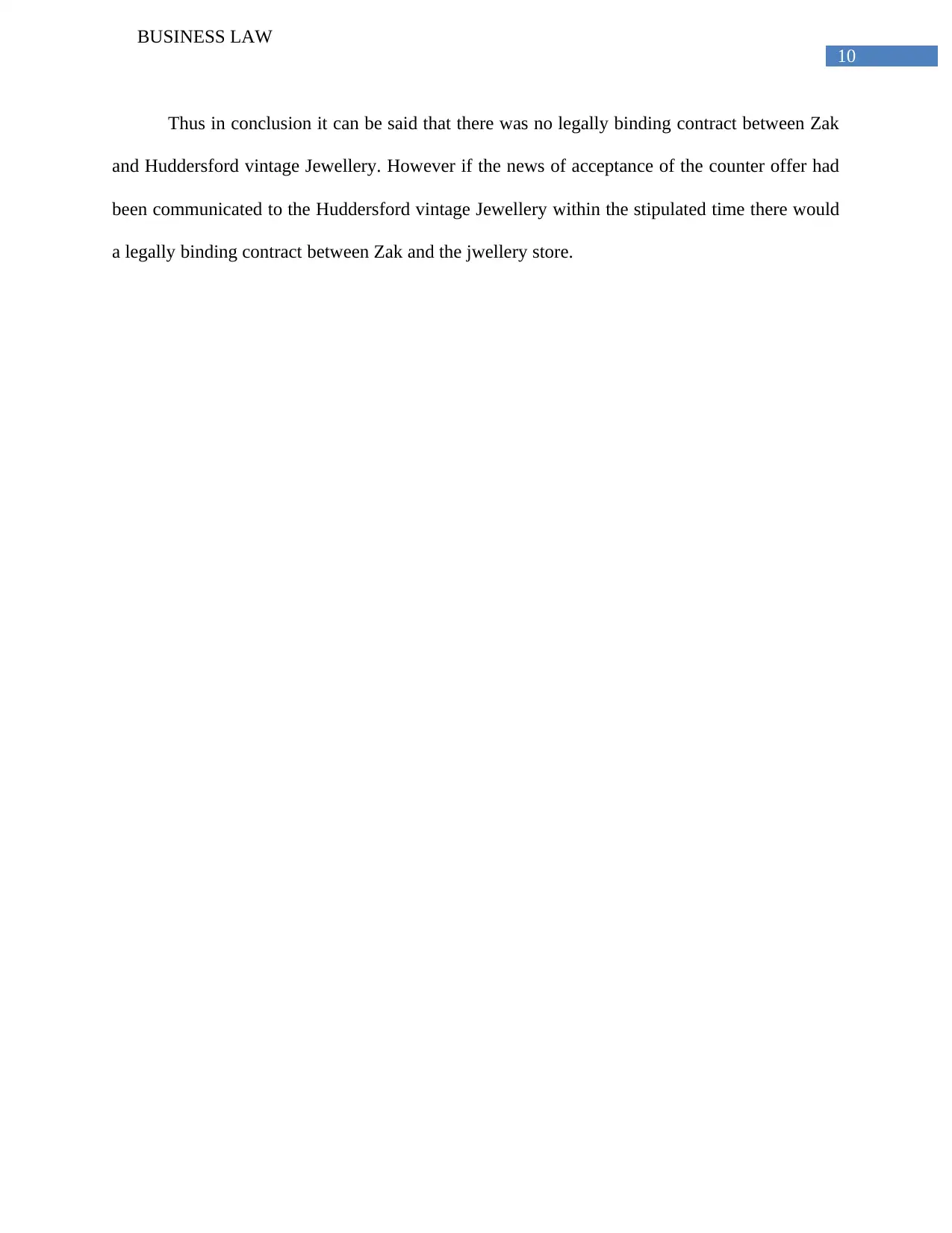
10
BUSINESS LAW
Thus in conclusion it can be said that there was no legally binding contract between Zak
and Huddersford vintage Jewellery. However if the news of acceptance of the counter offer had
been communicated to the Huddersford vintage Jewellery within the stipulated time there would
a legally binding contract between Zak and the jwellery store.
BUSINESS LAW
Thus in conclusion it can be said that there was no legally binding contract between Zak
and Huddersford vintage Jewellery. However if the news of acceptance of the counter offer had
been communicated to the Huddersford vintage Jewellery within the stipulated time there would
a legally binding contract between Zak and the jwellery store.
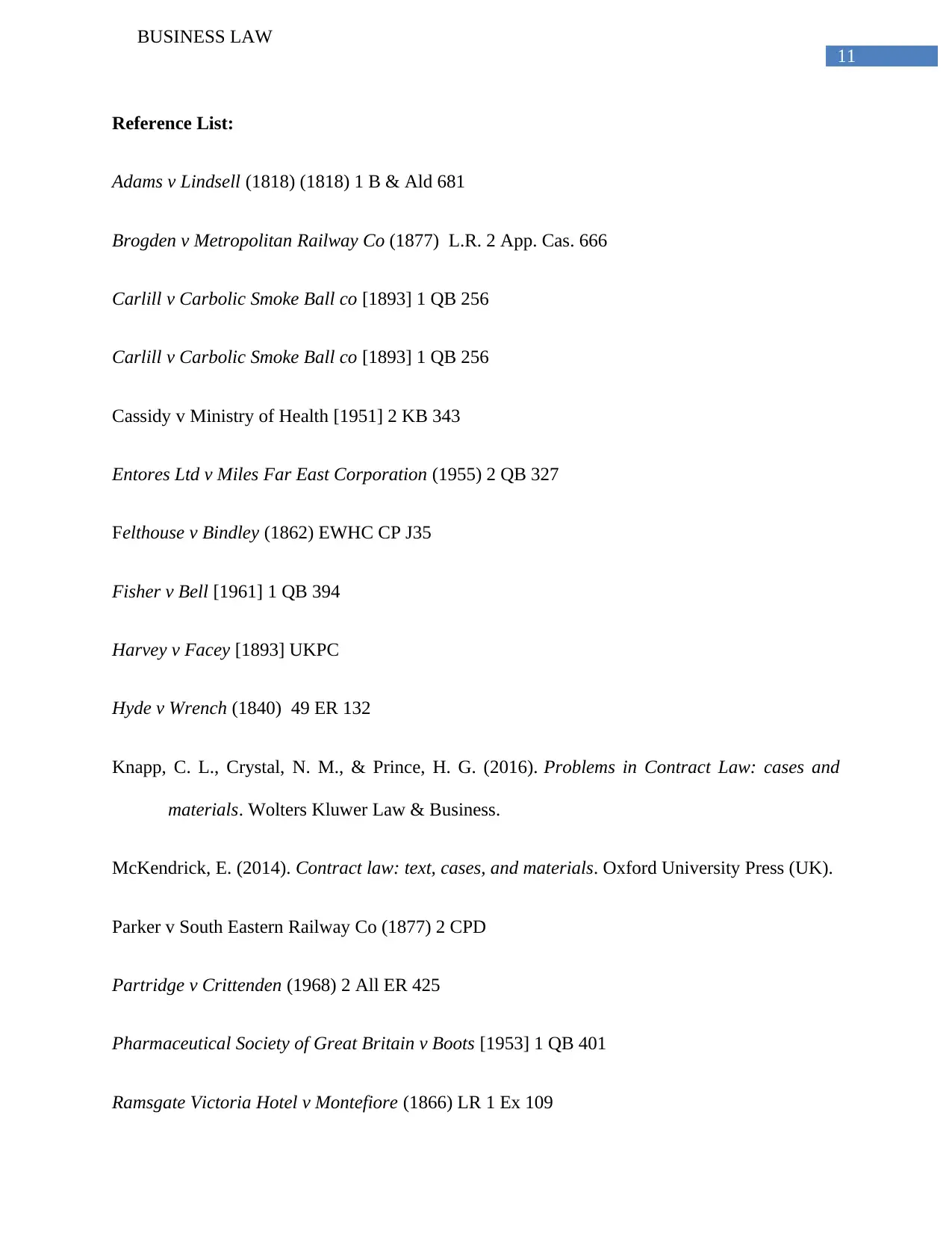
11
BUSINESS LAW
Reference List:
Adams v Lindsell (1818) (1818) 1 B & Ald 681
Brogden v Metropolitan Railway Co (1877) L.R. 2 App. Cas. 666
Carlill v Carbolic Smoke Ball co [1893] 1 QB 256
Carlill v Carbolic Smoke Ball co [1893] 1 QB 256
Cassidy v Ministry of Health [1951] 2 KB 343
Entores Ltd v Miles Far East Corporation (1955) 2 QB 327
Felthouse v Bindley (1862) EWHC CP J35
Fisher v Bell [1961] 1 QB 394
Harvey v Facey [1893] UKPC
Hyde v Wrench (1840) 49 ER 132
Knapp, C. L., Crystal, N. M., & Prince, H. G. (2016). Problems in Contract Law: cases and
materials. Wolters Kluwer Law & Business.
McKendrick, E. (2014). Contract law: text, cases, and materials. Oxford University Press (UK).
Parker v South Eastern Railway Co (1877) 2 CPD
Partridge v Crittenden (1968) 2 All ER 425
Pharmaceutical Society of Great Britain v Boots [1953] 1 QB 401
Ramsgate Victoria Hotel v Montefiore (1866) LR 1 Ex 109
BUSINESS LAW
Reference List:
Adams v Lindsell (1818) (1818) 1 B & Ald 681
Brogden v Metropolitan Railway Co (1877) L.R. 2 App. Cas. 666
Carlill v Carbolic Smoke Ball co [1893] 1 QB 256
Carlill v Carbolic Smoke Ball co [1893] 1 QB 256
Cassidy v Ministry of Health [1951] 2 KB 343
Entores Ltd v Miles Far East Corporation (1955) 2 QB 327
Felthouse v Bindley (1862) EWHC CP J35
Fisher v Bell [1961] 1 QB 394
Harvey v Facey [1893] UKPC
Hyde v Wrench (1840) 49 ER 132
Knapp, C. L., Crystal, N. M., & Prince, H. G. (2016). Problems in Contract Law: cases and
materials. Wolters Kluwer Law & Business.
McKendrick, E. (2014). Contract law: text, cases, and materials. Oxford University Press (UK).
Parker v South Eastern Railway Co (1877) 2 CPD
Partridge v Crittenden (1968) 2 All ER 425
Pharmaceutical Society of Great Britain v Boots [1953] 1 QB 401
Ramsgate Victoria Hotel v Montefiore (1866) LR 1 Ex 109
⊘ This is a preview!⊘
Do you want full access?
Subscribe today to unlock all pages.

Trusted by 1+ million students worldwide
1 out of 13
Related Documents
Your All-in-One AI-Powered Toolkit for Academic Success.
+13062052269
info@desklib.com
Available 24*7 on WhatsApp / Email
![[object Object]](/_next/static/media/star-bottom.7253800d.svg)
Unlock your academic potential
Copyright © 2020–2025 A2Z Services. All Rights Reserved. Developed and managed by ZUCOL.





